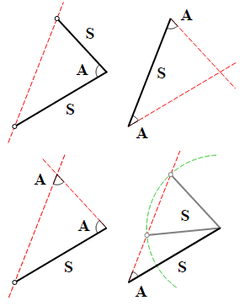Area of a Triangle
There are many different formulas that one can use to calculate the area of a triangle.
Contents
Basic Formula
This is the most common formula used and is likely the first one that you have seen.
For a triangle with base \(b\) and height \(h\), the area \(A\) is given by
\[ A = \frac{1}{2} b \times h.\ _\square \]
Observe that this is exactly half the area of a rectangle which has the same base and height. The proof for this is quite trivial, so there isn't much explanation needed. A logical reasoning for this is that you can make two triangles by dropping an altitude for which both halves are each rotated 180 degrees about their hypotenuse's mid-point to form two rectangles. Thus it is clear that the triangles are one half the area of their respective rectangles which have a total area of \(bh.\)
What is the area of the triangle pictured below?

Since the triangle has a base of 5 and a height of 8, the area is \( \frac{1}{2} \cdot 5 \cdot 8 = 20 \). \( _\square \)
Always keep in mind that the base and height are perpendicular. Here are some more examples.
What is the area of the triangle in the figure below?

The figure shows that the base is \(b=5\) and height is \(h=3.\) Therefore, the area is
\[\frac{1}{2}\cdot5\cdot3=\frac{15}{2}. \ _\square\]
In the figure below, the two lines \(l_1\) and \(l_2\) are parallel. If the area of \(\triangle ABC\) is 6, what is the distance between \(l_1\) and \(l_2?\)

The figure shows that the base \(\big(\)which is \(\overline{AB}\big)\) is \(b=4.\) Since lines \(l_1\) and \(l_2\) are parallel, the distance between them is the triangle's height \(h.\) Hence we have \(\frac{1}{2}\cdot4\cdot h=6 \implies h=3.\) Observe that even if we choose a different point upon \(l_1\) for \(C,\) the area will still remain the same. \(_\square\)

So you thought that the area of a triangle was simply \(\frac{bh}{2}\). Well, it turns out that there are many more ways to derive the area of a triangle than that.
Using Sine Rule
Consider the following triangle with angles \(A, B\), and \(C\) and corresponding opposite sides \(a,b\), and \(c\):
Then the area of triangle \(ABC\) is
\[(\text{Area}) =\frac{1}{2} ab\sin C = \frac{1}{2} bc\sin A = \frac{1}{2} ac\sin B = \frac{abc}{4R},\]
where \(R\) is the radius of the circumcircle of triangle \(ABC.\) \(_\square\)
We will prove the area is equal to \(\frac{1}{2} bc \sin A\). The other equalities can be proved similarly.
By drawing the height \(h\) of the triangle from vertex \(C\) to the opposite side, we know that the area of the triangle is
\[(\text{Area}) = \frac{1}{2} ch.\]
Now, \(\sin A = \frac{(\text{opposite})}{(\text{hypotenuse})} = \frac{h}{b}\), which implies \(h = b\sin A.\) Therefore,
\[(\text{Area}) = \frac{1}{2} ch = \frac{1}{2} c b \sin A.\]
By drawing the height \(h\) from the other two vertices, we can similarly show
\[(\text{Area}) =\frac{1}{2} ab\sin C = \frac{1}{2} ac\sin B.\]
To get the last equality, recall that the extended sine rule gives us \( \dfrac{a}{\sin A } = 2R \), and hence we get
\[ (\text{Area}) = \frac{1}{2} cb \sin A = \frac{ abc } { 4R }.\ _\square \]
For triangle \(ABC\), suppose we are given two side lengths \(a= 6, b= 5:\)

If the area of \(\triangle ABC\) is \(10,\) what is the value of \(\sin C?\)
By the above formula, the area of the triangle is given by
\[\begin{align} (\text{Area}) &= \frac{1}{2} ab\sin C \\ 10 &= \frac{1}{2} \cdot 6 \cdot 5 \sin C\\ \frac{20}{30} &= \sin C\\ \sin C&=\frac{2}{3}. \ _\square \end{align}\]
Triangle \(ABC\) has side length \(a=6\) and angles \(\angle A=30^{\circ}\) and \(\angle B=45^{\circ}\). Find the area of \(\triangle ABC\).
Using the law of sines, we have
\[\begin{align} \dfrac{a}{\sin{A}}&=\dfrac{b}{\sin{B}}\\\\ \dfrac{6}{\sin{30^{\circ}}}&=\dfrac{b}{\sin{45^{\circ}}}\\\\ \dfrac{6}{\hspace{3mm} \frac{1}{2}\hspace{3mm} }&=\dfrac{b}{\hspace{3mm} \frac{1}{\sqrt{2}}\hspace{3mm} }\\\\ b&=6\sqrt2. \end{align}\]
Since the interior angles sum to \(180^{\circ}\), \(\angle{C}=105^\circ\). Now, using the formula \(\frac{1}{2}ab \sin{C}\), we get
\[\begin{align} \frac{1}{2} \times 6 \times 6\sqrt2 \times \sin 105^\circ &=18\sqrt{2}\left(\dfrac{\sqrt6+\sqrt2}{4}\right) \\ &=9\sqrt{3}+9. \ _\square \end{align}\]
Heron's Formula
Heron's formula states that the area is \(\sqrt{s(s-a)(s-b)(s-c)},\) where \(s\) is the triangle's semi-perimeter \(\frac{a+b+c}{2}\). A little rearrangement of this yields
\[16A^2=(a+b+c)(-a+b+c)(a-b+c)(a+b-c),\]
where \(A\) is the area. \(_\square\)
Triangle \(XYZ\) has all integer side lengths, is inscribed in a circle of radius \(25,\) and has side lengths \(x=14\) and \(y=30\). What is the area of the triangle?
We know that the circumradius of the triangle is equivalent to \(R=\frac{xyz}{4T}\), where \(T\) is the area. We actually proved this above since it's a rearrangement of \(\frac{abc}{4R}\).
Plugging in our given values, we have
\[25=\dfrac{(14)(30)z}{4T}\implies 100T=420z.\]
The semi perimeter is \(\frac{14+30+z}{2}\), so by Heron's formula \(T\) becomes
\[\begin{align} T&=\sqrt{\left(22+\frac{z}{2}\right)\left(8+\frac{z}{2}\right)\left(-8+\frac{z}{2}\right)\left(22-\frac{z}{2}\right)}\\ &=\sqrt{\left(484-\frac{z^2}{4}\right)\left(\frac{z^2}{4}-64\right)}\\ &=\frac{1}{4} \sqrt{-z^4+2192z^2-495616}. \end{align}\]
Plugging in this value of \(T\) yields
\[25\sqrt{-z^4+2192z^2-495616}=420z.\]
Some bashing yields \(z=40,\) and plugging in our values into the equation, we have
\[(\text{Area})=\dfrac{abc}{4R}=\dfrac{(14)(30)(40)}{4(25)}=168. \ _\square \]
The proof of this is a little bit tricky, so I'll try to make it as simple as possible.
Begin with an arbitrary triangle \(ABC\) with base \(c\). Drop the altitude from angle \(C\) to side \(c\) and call it \(h\). Let the two segments of side \(c\) be \(m\) and \(n\) such that there are two right triangles \(ANH\) and \(BHM\) with sides \(a\) and \(b\) being their respective hypotenuses. Thus, the area of this triangle is \(\frac{1}{2}ch\).
Since \(m=c-n\), it follows that \(m^2=c^2-2cn+n^2\). Now, keeping that in mind, let's shift gears a bit.
By the Pythagorean theorem, \(b^2=h^2+m^2\) and \(a^2=h^2+n^2\). Getting back to our original equation, we add \(h^2\) to both sides to get
\[m^2+h^2=c^2-2cn+n^2+h^2.\]
Substituting in our Pythagorean equations above for \(h^2+n^2\) and \(h^2+m^2\), we get \(b^2=c^2-2cn+a^2.\) Isolating \(n\) gives \(n=\frac{a^2+c^2-b^2}{2c}.\)
Now, since \(h^2=a^2-n^2\), we can substitute our value of \(n\) to obtain
\[\begin{align} h^2 &= a^2-\left(\dfrac{a^2+c^2-b^2}{2c}\right)^2\\\\ &= \left(a-\dfrac{a^2+c^2-b^2}{2c}\right)\left(a+\dfrac{a^2+c^2-b^2}{2c}\right)\\\\ &=\left(\dfrac{2ac-a^2-c^2+b^2}{2c}\right)\left(\dfrac{2ac+a^2+c^2-b^2}{2c}\right)\\\\ &=\dfrac{\left(b^2-(a-c)^2\right)\left((a+c)^2-b^2\right)}{4c^2}\\\\ &=\dfrac{(b-a+c)(b+a-c)(a+c-b)(a+c+b)}{4c^2}\\\\ \Rightarrow h&=\dfrac{\sqrt{(b-a+c)(b+a-c)(a+c-b)(a+c+b)}}{2c}. \end{align}\]
Plugging this into our first equation \((\text{Area})=\frac{1}{2}ch\), we get
\[\begin{align} &\frac{1}{2}c\left( \dfrac{\sqrt{(b-a+c)(b+a-c)(a+c-b)(a+c+b)}}{2c}\right)\\\\ &=\dfrac{\sqrt{(b-a+c)(b+a-c)(a+c-b)(a+c+b)}}{4}. \end{align}\]
Substituting \(s=\frac{a+b+c}{2}\), we get
\[\begin{align} \dfrac{\sqrt{2(s)\cdot 2(s-a)\cdot 2(s-b)\cdot 2(s-c)}}{4} &=\dfrac{4\sqrt{(s)\cdot (s-a)\cdot (s-b)\cdot (s-c)}}{4}\\ &=\sqrt{s(s-a) (s-b) (s-c)}. \ _\square \end{align}\]
Shoelace Formula
The area of a triangle, given the coordinates of its vertices, is equal to the absolute value of
\[\frac 12 \det \begin{vmatrix} x_1 & y_1 & 1 \\ x_2 & y_2 & 1 \\ x_3 & y_3 & 1 \end{vmatrix} .\]
(The sign is positive if the points are given in clockwise order, and negative if they are in counterclockwise order.)
Upon expansion, we get \(\frac{1}{2}|x_1y_2-x_3y_2+x_3y_1-x_1y_3+x_2y_3-x_2y_1|.\)
If the triangle is in three dimensions, then the area becomes
\[\dfrac{1}{2} \sqrt{\left( \det\begin{vmatrix} x_1 & y_1 & 1 \\ x_2 & y_2 & 1 \\ x_3 & y_3 & 1 \end{vmatrix}\right)^2 + \left( \det \begin{vmatrix} x_1 & z_1 & 1 \\ x_2 & z_2 & 1 \\ x_3 & z_3 & 1 \end{vmatrix}\right)^2 + \left( \det \begin{vmatrix} z_1 & y_1 & 1 \\ z_2 & y_2 & 1 \\ z_3 & y_3 & 1 \end{vmatrix}\right)^2}.\]
Or, it is simply the absolute value of
\[\frac 12 \det \begin{vmatrix} x_1 & y_1 & z_1 \\ x_2 & y_2 & z_2 \\ x_3 & y_3 & z_3 \end{vmatrix} .\ _\square\]
The coordinates of the vertices of a triangle are given to be \(A=(1,7), B=(4,5), C=(10,12) \). Find the area of triangle \(ABC\).
We have
\[\begin{eqnarray} (\text{Area}) &=& \frac12 \begin{vmatrix}1 & 7 & 1 \\ 4 & 5 & 1 \\ 10 & 12 & 1 \end{vmatrix} \\ &=& \frac12 \big[ (1\cdot5 + 4\cdot12 + 10\cdot7) -(4\cdot7+5\cdot10+12\cdot1) \big] \\ &=& 16\tfrac12.\ _\square \end{eqnarray} \]
Triangle \(ABC\) exists in the 2D Cartesian plane and has two vertices at points \(A=(2,3)\) and \(B=(-3,9)\). Point \(C\) exists on the parabola \(y=x^2-1\) such that the \(x\)-coordinate of point \(C\) satisfies \(-3<x<3\). Find the maximum possible area of triangle \(ABC\).
We begin by plugging in our givens: \(\frac{1}{2}\big|(2-x_c)(9-3)-(2+3)(y_c-3)\big|.\)
Substituting \(y=x^2-1\) and expanding, we get \(\frac{1}{2}\big|(x-2)(5x+13)\big|.\)
Using \(\frac{-b}{2a}\), the maximum occurs at \(x=-\frac{3}{10}\).
However, since this is an absolute value equation and both roots occur between \(-3\) and \(3\), we must check to see which value of \(x={-3,3,-\frac{3}{10}}\) maximizes the function. Thus, after a little plugging and chugging, we find that \(x=\frac{3}{10}\) yields the greatest value for the area of triangle \(ABC,\) which is \(\frac{529}{40}.\) \(_\square\)
There are several elegant proofs for this that use vector cross products, determinants, and calculus. However, since this is a wiki on geometry, I will post the simplest geometric proof. Unfortunately, even though this is the simplest, it's also the ugliest.
For simplicity's sake, denote \(x_1=a, ~ x_2=b,~ x_3=c,~ y_1=d, ~ y_2=e, ~ y_3=f\).
By this we have coordinates \((a,d), (b,e), (c,f)\). (I know this isn't proper, but trust me, it gets ugly.) Our formula is now \(\frac{1}{2}\big|(a-c)(e-f)-(a-b)(d-f)\big|.\)
Next, by the distance formula, we have the following:
From \((a,d)\) to \((b,e)\), we get \(\sqrt{(a-b)^2-(d-e)^2}\), and set this equal to \(p.\)
From \((a,d)\) to \((c,f)\), we get \(\sqrt{(a-c)^2-(d-f)^2}\), and set this equal to \(q.\)
From \( (b,e)\) to \((c,f)\), we get \(\sqrt{(b-c)^2-(e-f)^2}\), and set this equal to \(r.\)By Heron's formula, we get \(16T^2=(p+q+r)(-p+q+r)(p-q+r)(p+q-r).\)
After massive expansion by plugging in our givens \(p, q,\) and \(r\), we get
\[16T^2=4(b d-c d-a e+c e+a f-b f)^2,\]
which can be factored to
\[(a-c)(e-d)-(a-b)(f-d).\]
Note that \(\sqrt{x^2}=|x|.\) Thus, after square rooting both sides, we get
\[|T|=\frac{1}{2}\big|(a-c)(e-d)-(a-b)(f-d)\big|. \ _\square\]
Calculating Area
 If each square has a side length of 1, what is the area of the blue trapezoid?
If each square has a side length of 1, what is the area of the blue trapezoid?
Note: A trapezoid has at least a pair of parallel sides. It is also known as a trapezium in the UK.

A square and a "shuriken" (throwing star) are drawn over the \(4\times 4\) grid formed by 25 equally spaced dots, as shown above.
Which colored region has a larger area?
 Find the area of the triangle shown.
Find the area of the triangle shown.

As shown, a square is partitioned into 4 colored triangles, and the number in each triangle indicates the area of that triangle.
What is the area of the blue triangle?
Problem Solving - Basic
Now that you have learned all of the different possible formulas, let's look at some examples.
If the two side lengths of a triangle are given to be 10 and 11, what is the maximum possible area of this triangle?
Since the formula of the area of the triangle is \(\frac12 ab \sin C \) with \(0 < \sin C \leq 1 \), the maximum area occurs at \(\sin C = 1 \). So the area is \( \frac 12 \cdot 10 \cdot 11 \cdot 1 = 55. \ _\square\)
Note that the area is maximized when the triangle is a right triangle.
Which of the following triangles has a larger area:
- triangle A with side lengths \( 13, 13, 10 \), or
- triangle B with side lengths \( 13, 13, 24\, ?\)

The rectangle in the diagram has an area equal to 640 \(\text{cm}^2\).
Points B and F are midpoints of sides AC and AE, respectively.
What is the area of triangle BDF in \(\text{cm}^2?\)
 In the diagram, relative lengths of some line segments are as follows:
In the diagram, relative lengths of some line segments are as follows:
\[\begin{array} &CE=AE, &DB=2AD, &CF=3BF. \end{array}\]
If the area of \(\triangle ABC\) is \(24,\) what is the area of \(\triangle DEF?\)

The radius of the circle is \(20\) and \(\angle AOB=\frac{3}{10} \pi.\)
If \(C\) is a point on \(\overline{BO}\) such that \(\overline{AC}\) is the bisector of \(\angle BAO,\) what is the length of \(\overline{BC}?\)
Round your answer to 3 decimal places.

In the figure, \( \Delta ABC \cong \Delta EDF \) with \(\overline{AC} = \overline{EF} = 8\).
If \( \Delta DEF\) is positioned in such a way that \(D\) lies along \(\overline{AB}\) and the area of polygon \(ADEC\) is \(28,\) what is the length of \(\overline{FC}?\)
Problem Solving - Intermediate
Determine the area of a triangle with side lengths \(6,7,8\).
Let the side lengths be denoted as \(a=6,b=7,c=8\) with the angle opposite to side length \(a\) being \(A \). By the cosine rule, we have \(a^2 = b^2 + c^2 - 2bc \cos A \). Solving for \(A\) yields \(\cos A\approx \frac{11}{16} \) or \(\sin A = \sqrt{1 - \cos^2 A} = \frac{\sqrt{135}}{16} \). Note that we are only taking the positive square root because the sine of any angle of a triangle is non-negative.
Hence, the area is
\[ (\text{Area}) = \frac12 bc \sin A = \frac12 \cdot 7 \cdot 8 \cdot \frac{\sqrt{135}}{16} =\frac74 \sqrt{135} \approx 20.333. \ _\square\]
Note that we can also get the area of this triangle using Heron's formula: \((\text{Area}) = \sqrt{s(s-a)(s-b)(s-c)}.\)

In the square shown, the areas of the white triangles are 7, 9, and 11.
What is the area of the shaded triangle?
Give your answer to 2 decimal places.
Find all possible areas of a triangle with \(2\) sides of lengths \(11\) and \(12\) and one \(60^{\circ}\) angle.
If the sum of the areas of the \(3\) smallest triangles is \(a\sqrt{b},\) where \(a\) and \(b\) are integers and \(b\) is square-free, enter your answer as \(a+b\).

- This is part of the set Trevor's Ten.
- Useful Brilliant wiki: Area of a Triangle
- Image Credit: Wikimedia Congruent Triangles by Ilmari Karonen
In geometry, Heron's formula states that the area of a triangle whose sides have lengths \(a\), \(b\), and \(c\) is
\[A = \sqrt{s(s-a)(s-b)(s-c),}\]
where \(s\) is the semiperimeter of the triangle, that is,
\[s = \frac{a+b+c}{2}.\]
Heron's formula can also be written as
\[\begin{eqnarray} A &=& \frac{1}{4}\sqrt{(a+b+c)(a+b-c)(b+c-a)(c+a-b)} \\ &=&\frac{1}{4}\sqrt{2\left(a^2 b^2+b^2c^2+c^2a^2\right)-\left(a^4+b^4+c^4\right)} \\ &=& \frac{1}{4}\sqrt{\left(a^2+b^2+c^2\right)^2-2\left(a^4+b^4+c^4\right)} \\ &=& \frac{1}{4}\sqrt{4a^2b^2-\left(a^2+b^2-c^2\right)^2}. \end{eqnarray}\]
Two other area formulas have the same structure as Heron's formula but are expressed in terms of different variables.
First, denoting the medians from sides \(a\), \(b\), and \(c\) respectively as \(u, v\) and \(w\) and their semi-sum as
\[\sigma = \frac{u+v+w}{2},\]
we have
\[A = \frac{4}{3}\sqrt{\sigma(\sigma-u)(\sigma-v)(\sigma-w)}.\]
Next, denoting the altitudes from sides \(a\), \(b\) and \(c\) respectively as \(p\), \(q\), and \(r\), and denoting the semi-sum of the reciprocals of the altitudes as
\[H = \frac{p^{-1}+q^{-1}+r^{-1}}{2},\]
we have
\[A^{-1} = 4 \sqrt{H\left(H-p^{-1}\right)\left(H-q^{-1}\right)\left(H-r^{-1}\right)}.\]
Other formulae include
- \(\frac {1}{2} b h,\) where \(b\) is the base and \(h\) is the height;
- \(\frac {1}{2} a b \sin C,\) where \(C\) is the angle, with arms \(b\) and \(c;\)
- \(\frac {abc}{4R},\) where \(R\) is the circumradius;
- \(rs,\) where \(r\) is the inradius and \(s\) is the semi-perimeter;
- Pick's theorem for the area of a lattice polygon.